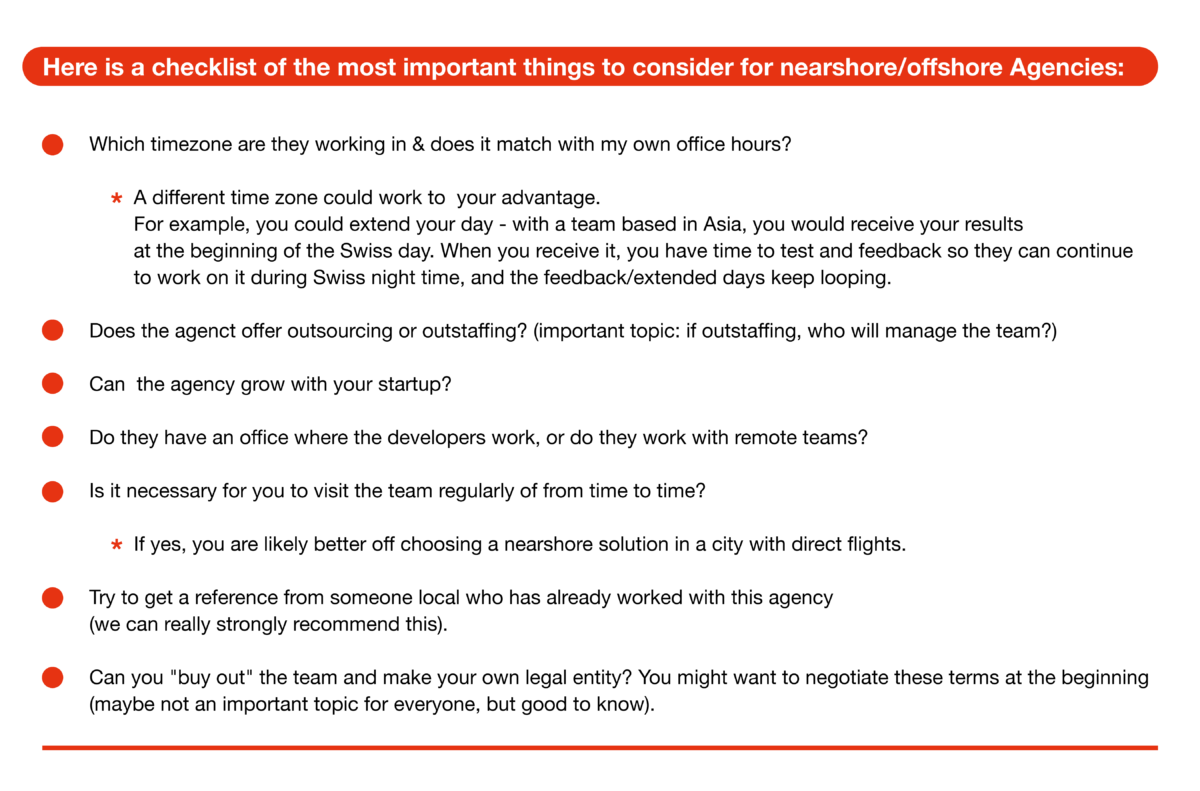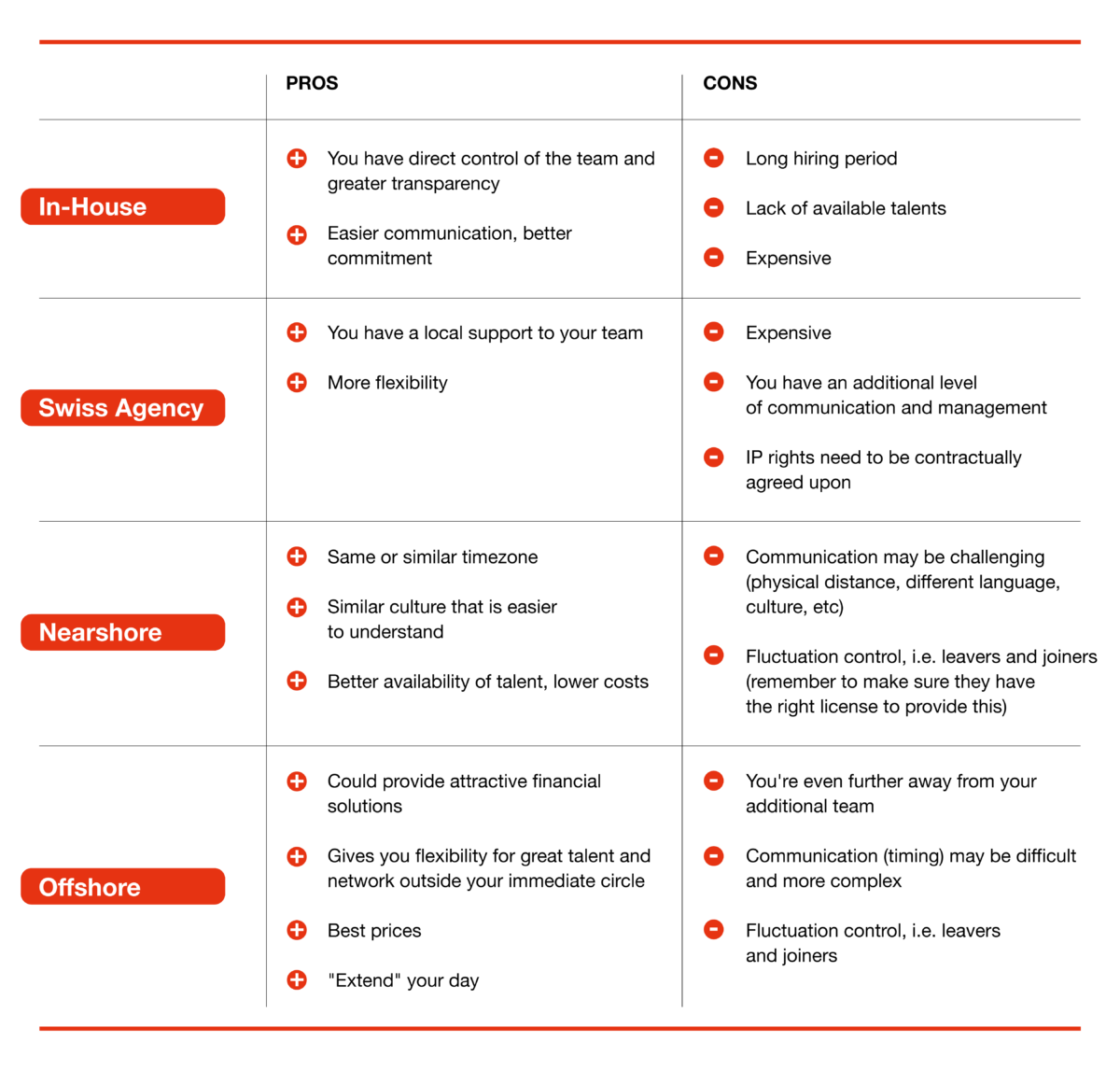
A guide to Offshoring and Nearshoring
IT Insights: In-house, Swiss Agency, Nearshoring & Offshoring
Visit the IT-Desk for our trusted partners
Whether you are looking at digitizing processes, setting up a website or a CRM system, or producing a SaaS, it is inevitable as you build and develop your startup that you will need to implement some key IT structures. Before looking further, you should have already considered which IT solutions you are looking to implement or develop and how important it is for your company (at this stage). Once you have identified which IT infrastructure you need to get up and running as a critical function of your business, you will likely be confronted with which best strategy and options you can choose from. Within the Swiss landscape, IT resources can be limited and also expensive. So, in this article, we will walk you through the various resources and methodologies you can consider for your start-up and make sure you are able to discover the right option for you.
First Things First: What’s The Difference Between Nearshoring & Offshoring?
To keep it simple: nearshoring is a term used when a company outsources to countries that are close to their own time zones, whereas offshore is a term used for outsourcing to countries with much bigger gaps within time zones.
As an example for a company in Switzerland, they could nearshore projects to Spain, Portugal, Ukraine, Poland etc. or offshore projects to India, Pakistan, Malaysia, China, South America, etc.
There is also a difference between outsourcing and outstaffing. Outsourcing a project means that the whole project is taken on by the agency you have assigned it to. The advantage in this situation is you do not need the in-house expertise to deliver the project. However, it is also the more expensive solution as the agency will need to invest more resources on their behalf to be able to deliver. Outstaffing, on the other hand, means you lead the project but you are assigned as many staff as required from the agency. The staff is integrated into your company on an interim basis, which provides you the expertise or resources you need in addition to your in-house team as you continue to lead and manage the project.
The Four IT Set-Up Options
Inhouse
Hiring developers and setting up an IT team locally is arguably the most direct set-up. Though, as we mentioned at the start, if you are a Swiss startup, the resources may not be readily available or may be out of budget as you get things up and running.
Swiss Agencies
Should you need IT set-up for a short period of time, for the duration of a project, or just need extra hands on deck, hiring through a Swiss agency could provide you the right support. The team hired would be external to your company and payments for the services can be placed on a project basis, hourly basis, or with a flat rate, depending on the agreed-upon contract.
Some things to consider when going with a Swiss agency are whether the developers are located locally or whether they work with nearshore/offshore locations. Also, consider if the Swiss agency offers outsourcing or outstaffing based on your requirements. Very important is also to make sure that the Swiss agency has the legal personnel-leasing licence to be able to provide the services they offer.
Whether you outsource developer resources via nearshore or offshore, you have various options on how to employ abroad. Only rarely are developers directly employed abroad, mostly due to legal uncertainties across borders. In most cases, an agency or third party is involved for contracting, legalities and insurance. The developers and staff assigned to your company are 100% committed to your project and tasks (most of the time, it’s better if the developers only work for your company and don’t work for other projects at the same time). As an alternative, there are also agencies that will provide your start-up with a fixed contact person (often a project manager) which organises your required resources internally, meaning you don’t really have any direct contact with the developers throughout your project.
In all cases, the most important thing is that the delivery/KPIs are clearly communicated.

So, What’s The Best Solution?
This is not a one-solution-fits-all subject. How you decide to set up the IT and developers for your company depends on your timing, resources, budget, and general requirements. To help you consider your options, we created a chart highlighting the advantages and disadvantages we see within each option.

Tips & Considerations
- Regardless of the option you choose, make sure you can document and save all of the work you are doing as intellectual business property. This will support you in keeping control of your assets as well as protect you legally (technically protect the source code).
- If you choose to hire via an agency, offshore, or nearshore, make sure to continuously check in with your team and establish strong communication channels. Transparency and connectivity are critical to your success.
- As you kick things off and are excited to set up your systems, do not forget to set up clear structures and implement management tools to support your success.
- In case the development team uses open source software (OSS) libraries: make sure to get proper documentation of the libraries, OSS Licenses, etc. (to avoid copyleft).
- Assess your situation, need, and product and prioritize the IT solution accordingly. I.e., if the IT you are building is the actual product of your business – we would highly suggest you keep your CTO in-house rather than off/nearshore the development. However, if the IT you are looking to implement is a tool that isn’t even worth a mention or development of basic but time-consuming codes, handing the lead over to an external could support your project and internal efficiency.
- Most importantly, make sure you hire the best fit overall! The quality of the agency you choose in relation to your requirements outweighs any short communication channels, time zone advantages, or financial wins. Spend your time to assess the agency before making a commitment: are their motivations aligned with yours, do they have the business knowledge to fulfill your needs, do they offer the right IT architects and insights to deliver within your requirements and timelines, etc.?
Make sure they are trying to actively bring your startup to the next step!
There you have it, a high-level insight about IT structures in-house, Swiss agencies, nearshoring, and offshoring. With this overview and bag of knowledge, we wish you all the best with your decisions as you build up your start-up’s IT systems. Remember, we are here to support you along the way! If you have any questions or would benefit from more detailed information on the topic, don’t hesitate to get in touch with our team at the Swiss Startup Association.
Visit the IT-Desk for our trusted partners
CO-AUTHORS

Julian Stylianou

Adele Bottoni

Michael Dudli

Noah Schiller
CONTRIBUTERS

Patrick Mark

Simona Fontanella

Raphael Tobler


